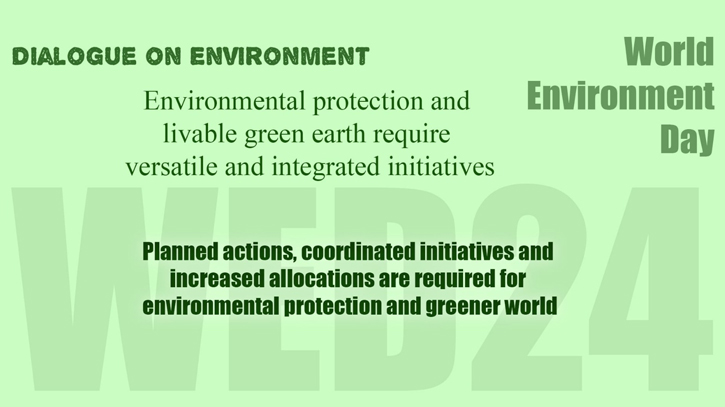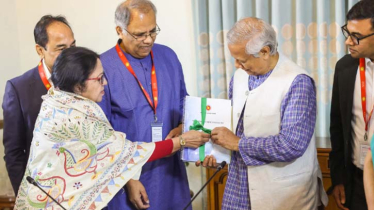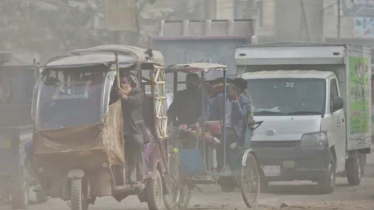
Photo : Courtesy
Saturday (June 8) PSDI Consultancy, ASED Habigonj and Share the Planet Association, Japan jointly organized an online environmental dialogue titled “Environmental protection and need for a liveable green planet requires multifaceted and integrated initiatives”.
The discussants are Chief Executive Officer of ASED Habiganj Jafar Iqbal Chowdhury; Executive Director of Faith in Action Nripen Vaidya; Coordinator of Sundarbans and Coast Protection Movement Nikhil Chandra Bhadra; Executive Director of Upma Nari Kallyan Sangstha Cox's Bazar Papiya Dey; President of Environmental Organization People's Voice Chittagong Sharif Chowhan; Faculty coordinator of Bandarban University's School of Business Administration Shaing Shaing U Nini; trade union leader Khairul Mamun Mintu and development researcher and anthropologist Tuhin Sarkar.
The discussants emphasized planned actions, coordinated initiatives and increased allocations for environmental protection and a greener world.
Nikhil Bhadra said, that due to Cyclone Remal, the livelihood of the coastal area is under extreme risk today. The Sundarbans act as a shield against cyclones. However, there is no initiative to protect the biodiversity in the Sundarbans area, instead, many activities for destruction are going on. To protect biodiversity in the Sundarbans area, initiatives should be taken to protect animals like the shelter project. The coastal houses need to be turned into shelters. Already, the government has allocated a budget for environmental protection, but no specific sector has been determined for that allocated expenditure. Local people should be involved in budget implementation.
Nirpen Vaidya said, considering the disaster, various organizations including the World Bank is interested in giving loans instead of grants. However, the developed countries are mostly responsible for climate change. But these developed countries are more interested in investing in weapons and less in environmental protection. On the other hand, we are also responsible for the destruction of this environment. People in the coastal areas are still trapped in water due to Remal. Even though the risk of death has been reduced to a large extent due to government initiatives, livelihoods have been severely affected. Disaster risk reduction should be done through the involvement of local people.
Papia Dey said, the forced migration of Rohingyas has been going on for a long time, and this area has a special importance as it is a combination of sea and mountains. Due to Rohingya infiltration, forest areas have been destroyed, elephant movement routes have been destroyed, mountains have been destroyed, agricultural land has been destroyed, and the wildlife of the area has been severely damaged due to the lack of unplanned development plans.
Sharif Chawhan said we are in extreme danger today in Chittagong. The city was known for its rivers, mountains and seas. But Chittagong is no longer in that position due to hill cutting, river encroachment and unplanned urbanization. The sewage system of the city has completely broken down, the river water is being polluted, roads are being cut by mountains, landslides are happening. Chittagong city is gradually becoming unlivable due to the lack of will to improve the environment on the part of people associated with the formulation and implementation of urban planning. It is important to implement the 1961 Urban Development Master Plan for sound urban management.
Shaing Shaing U Nini said, about 80 thousand hectares of land has been destroyed in the Chittagong hill district. 80% of people have no land of their own, and even no specific policy framework. Trees are being cut down in pursuit of livelihood, agricultural production is being disrupted due to unplanned agricultural systems. Sometimes the private sector especially in the name of the development of the tourism industry is destroying the vital nature of hilly areas. It is important to formulate integrated initiatives and participatory planning for the environmental protection of hilly areas. Creating a planned tourism industry; where youth can be involved and a community-based tourism system can be developed, employment will be created, as well as environmental protection will play a role. A comprehensive awareness raising program should be adopted by the government.
Tuhin Sarker said that the northern region of Bangladesh is completely affected by geopolitical complications. As a result, the rivers are continuously drying up which is completely affecting the agricultural economy and livelihood of the people. The Tista River is one of the regulators of agriculture in North Bengal, which is gradually turning towards desertification due to the drying up of the river. To sustain agriculture, the government has installed deep tube wells which will lead to long term crisis. Agricultural workers are migrating and choosing new occupations, the solution to this problem should not only be thought of in Bangladesh, but it should also be seen as a regional problem and the implementation of agreements related to inter-country rivers is most important.
Zafar Iqbal Chowdhury said that the Haor area is one of the most vulnerable areas of environmental disaster, but it is the most neglected. About 1/5th of the total food grains come from the Haor area. Haor is one of the sources to meet the food demand of the country. A certain area of Haor is under ice at certain times of the year, which is mainly due to the oppression of the nature of people of neighbouring countries. Materially there is a deficiency in the government's development plan, rivers and canals are silted up, and areas are being flooded due to upstream water, which is about 25% food grain loss affecting the overall economy. For this, it is necessary to arrange the re-excavation of canals for environmental protection.
Messenger/Sajib








